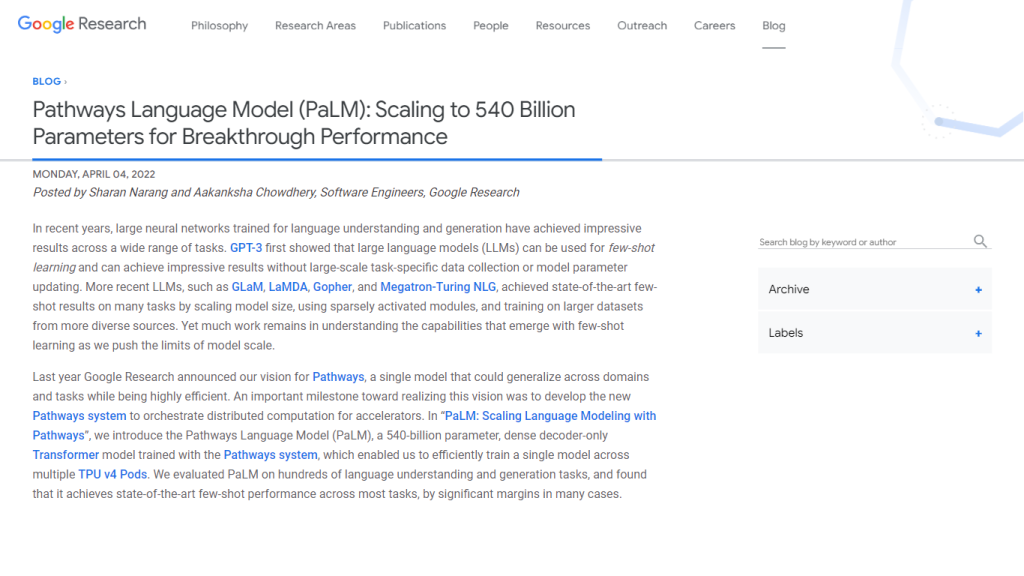What is PaLM?
Very recently, Google has proposed probably the world’s largest language model, PaLM, which has as many as 540 billion parameters. This marks a whole new frontier in natural language understanding and generation using few-shot learning to reduce the massive efforts of data collection and specific task tuning. Based on the Pathways system by Google, PaLM deploys a dense decoder-only Transformer architecture running on multiple TPU v4 Pods, thus demonstrating distributed computation at work. It achieves state-of-the-art performances across a wide range of tasks in tens of languages—in particular, reasoning and generation of code. A key strength of PaLM is its very strong focus on ethical concerns around AI development.
PaLM’s Key Features & Benefits
540 Billion Parameters: This scaling of PaLM to an unprecedented 540 billion parameters empowers advanced language understanding.
State-of-the-Art Few-Shot Learning: The model has very advanced, state-of-the-art few-shot learning abilities that make it versatile for use in many different languages tasks without extensive retraining.
High Efficiency on TPU v4 Pods: Empowered by the advanced TPU technology from Google, this enables efficient training across a distributed system with a high hardware FLOPs utilization.
Excels at diverse tasks at state-of-the-art levels in reasoning, language understanding, code generation, among others.
Ethical Quotient of AI: It has an exhaustive framework of model bias detection and risks associated with it, ensuring to focus on the ethos of responsible AI development.
Use Cases and Applications of PaLM
The versatility of PaLM allows it to find applications across various industries and tasks, notably in the following:
-
Natural Language Processing:
The applications of this include chatbots, virtual assistants, customer service applications. -
Code Generation:
It is very good at code generation. Hence, it helps software developers automate repetitive coding tasks. -
Multi-Step Reasoning:
It has advanced reasoning abilities; thus, it can be applied in complex problem-solving scenarios. -
Multi-Language Translation:
With several languages supported, PaLM can be used in translation services, making it easier to break language barriers.
How to Use PaLM
Using PaLM requires a few simple steps:
-
Access the Platform:
Log into the platform that PaLM is integrated into, for example, an application or API. -
Provide the Input Data:
Enter the information to be processed by PaLM in order to complete the task at hand. Information can be in the form of a text snippet, problem in coding, or a language translation request. -
Adjust Settings:
Configure various settings or parameters to get your desired output. -
Run the Model:
Run the model and allow PaLM to process the input to generate the desired output. -
Review Results:
Once PaLM has thrown up results, review them and make adjustments or fine-tuning as needed.
Best Practices:
Keep your input data clean and well-formatted for the most accurate results. Many of the features in PaLM’s user interface can be utilized effectively once one becomes familiar with it.
How PaLM Works
Underlying this technology is a dense decoder-only Transformer model. Google’s Pathways system makes sure of scaling up efficiently across multiple TPU v4 Pods. The few-shot learning approach empowers PaLM in accomplishing any particular task with least data and task-specific tuning. Technology achieves a high hardware FLOPs utilization in making sure computational resources are used effectively.
Pros and Cons of PaLM
Pros:
- It scales up to 540 billion parameters to learn language much deeper.
- Few-shot learning is effective, requiring fewer large-scale training setups.
- High efficiency in the TPU v4 Pods ensures that computational resources will be well utilized.
- Excels on most reasoning and code generation tasks.
- The development of the model focuses on ethical AI, accompanied by an elaborate bias/risk analysis.
Possible Cons:
- The model complexity is hard to handle by less-experienced users.
- High computation needs from the user make it inaccessible to smaller organizations.
Users generally praise PaLM’s outstanding performance and flexibility, but some customers indicate the need for more clear implementation guides with clearer instructions.
Conclusion on PaLM
PaLM is a huge leap toward AI-powered understanding and generation of languages. Not to mention the fact that it is equipped with 540 billion parameters, few-shot learning capabilities, and is really outstanding in several tasks—like natural language processing and generating code with its TPU v4 Pods efficiently. But more importantly, it places a significant emphasis on ethical considerations that underpin its value as a responsible AI tool. But naturally, most of the benefits that PaLM offers outweigh some of the challenges related to complexity and computation requirements. Of course, further updates and developments will be made in the future to enhance these capabilities, thus cementing the status of this AI language model.
PaLM FAQs
-
What is PaLM?
PaLM is a dense decoder-only Transformer model with 540 billion parameters; it achieves breakthrough performance in understanding and generating languages with few-shot learning. -
Where is the information about PaLM published?
Information about PaLM is published on the Google Research Blog. -
Which technology did Google use to train PaLM?
It used the advanced TPU v4 Pods for training PaLM, allowing efficient scaling across distributed computational systems. -
What are the areas that PaLM excels in?
Other than in natural language processing, PaLM returned impressive results on coding tasks, multi-step reasoning, and multi-language translation. -
Does it consider ethical concerns with respect to AI?
Yes, the potential risks that might emerge in language models are taken into consideration in PaLM, focused on transparent reporting and ethical AI practice.










